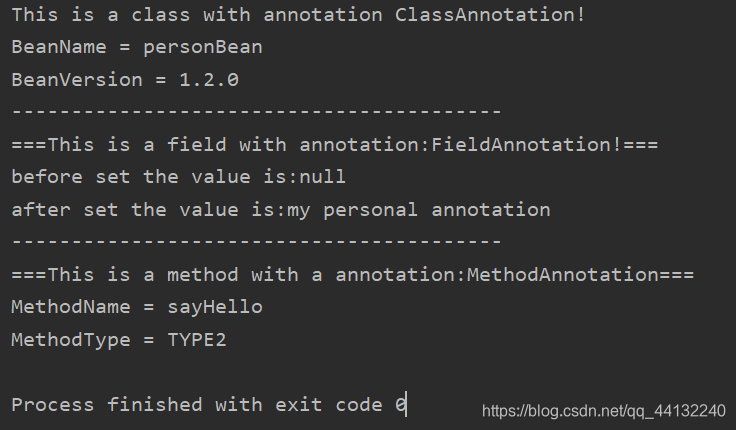一、什么是注解
Annontation是Java5开始引入的新特征,中文名称叫注解。它提供了一种安全的类似注释的机制,用来将任何的信息或元数据(metadata)与程序元素(类、方法、成员变量等)进行关联。为程序的元素(类、方法、成员变量)加上更直观更明了的说明,这些说明信息是与程序的业务逻辑无关,并且供指定的工具或框架使用。Annontation像一种修饰符一样,应用于包、类型、构造方法、方法、成员变量、参数及本地变量的声明语句中。
Java注解是附加在代码中的一些元信息,用于一些工具在编译、运行时进行解析和使用,起到说明、配置的功能。注解不会也不能影响代码的实际逻辑,仅仅起到辅助性的作用。包含在 java.lang.annotation 包中。
二、注解的分类

由上图可知:注解共分为:标记注解、标准元注解、一般注解三类。
【注】:Deprecated注解,除了多个删除线,并没有什么拦截功能。
三、标准元注解详解
标准元注解是自定义注解的注解,主要包含4个,都位于java.lang.annotation包中,我们创建自定义注解时会用到4个标准元注解。它们的名称以及含义如下:
-
@Documented:用于描述其它类型的annotation应该被作为被标注的程序成员的公共API,因此可以被例如javadoc此类的工具文档化。是一个标记注解,没有成员。
-
@Inherited:是否允许子类继承该注解
-
@Retention:定义了该注解的生命周期:某些注解仅出现在源代码中,而被编译器丢弃;而另一些却被编译在class文件中;编译在class文件中的注解可能会被虚拟机忽略,而另一些在class被装载时将被读取(请注意并不影响class的执行,因为注解与class在使用上是被分离的)。使用这个元注解可以对自定义注解的“生命周期”进行限制。
生命周期策略枚举
RetentionPolicy.RUNTIME注解会在class字节码文件中存在,在运行时可以通过反射获取到。
RetentionPolicy.CLASS 默认的保留策略,在类加载的时候丢弃。在字节码文件的处理中有用。注解默认使用这种方式。
RetentionPolicy.SOURCE 在编译阶段丢弃。这些注解在编译结束之后就不再有任何意义,所以它们不会写入字节码。@Override, @SuppressWarnings都属于这类注解。 -
@Target:说明了注解所修饰的对象范围:注解可被用于 packages、types(类、接口、枚举、Annotation类型)、类型成员(方法、构造方法、成员变量、枚举值)、方法参数和本地变量(如循环变量、catch参数)
修饰范围枚举
ElementType.CONSTRUCTOR 作用于构造器
ElementType.FIELD 作用于域/属性
ElementType.LOCAL_VARIABLE 用于描述局部变量
ElementType.METHOD 作用于方法
ElementType.PACKAGE 用于描述包
ElementType.PARAMETER 用于描述参数
ElementType.TYPE 用于描述类、接口(包括注解类型) 或enum声明,最常用
ElementType.ANNOTATION_TYPE 另一个注解 -
@Repeatable:Repeatable 自然是可重复的意思。@Repeatable 是 Java 1.8 才加进来的,所以算是一个新的特性。什么样的注解会多次应用呢?通常是注解的值可以同时取多个。举个例子,一个人他既是程序员又是产品经理,同时他还是个画家。
四、自定义注解
1、自定义类注解ClassAnnotation
package com.xsl;
import java.lang.annotation.*;
/**
* @Description 自定义类注解
* @Author xsl
* @Date 2020/1/8 11:58
**/
@Documented
@Retention(RetentionPolicy.RUNTIME)
@Target(ElementType.TYPE)
public @interface ClassAnnotation{
String name() default "defaultService";
String version() default "1.0.0.RELEASE";
}
2、自定义域注解FieldAnnotation
package com.xsl;
import java.lang.annotation.*;
/**
* @Description 自定义域注解
* @Author xsl
* @Date 2020/1/8 11:58
**/
@Documented
@Target(ElementType.FIELD)
@Retention(RetentionPolicy.RUNTIME)
public @interface FieldAnnotation {
String name() default "defaultName";
String value() default "defaultValue";
}
3、自定义方法注解枚举MethodTypeEnum
package com.xsl;
/**
* @Description 方法类型枚举
* @Author xsl
* @Date 2020/1/8 11:58
**/
public enum MethodTypeEnum {
TYPE1,TYPE2
}
4、自定义方法注解MethodAnnotation
package com.xsl;
import java.lang.annotation.*;
/**
* @Description 自定义域注解
* @Author xsl
* @Date 2020/1/8 11:58
**/
@Documented
@Retention(RetentionPolicy.RUNTIME)
@Target(ElementType.METHOD)
public @interface MethodAnnotation {
String name() default "defaultName";
MethodTypeEnum type() default MethodTypeEnum.TYPE1;
}
五、测试注解
1、测试注解类
package com.xsl;
/**
* @Description 注解测试类
* @Author xsl
* @Date 2020/1/8 11:58
**/
@ClassAnnotation(name = "personBean",version = "1.2.0.RELEASE")
public class Person {
@FieldAnnotation(name = "desc",value = "my personal annotation")
private String desc;
public String getDesc() {
return desc;
}
public void setDesc(String desc) {
this.desc = desc;
}
@MethodAnnotation(name="sayHello", type = MethodTypeEnum.TYPE2)
public void sayHello() {
System.out.println("Hello Annotation!");
}
}
2、测试类
package com.xsl;
import java.lang.reflect.Field;
import java.lang.reflect.Method;
/**
* @Description 测试类
* @Author xsl
* @Date 2020/1/8 13:02
**/
public class TestMyAnnotation {
private static Person person = new Person();
public static void main(String[] args) throws Exception {
testClassAnnotation();
System.out.println("-----------------------------------------");
testFiledAnnotation();
System.out.println("-----------------------------------------");
testMethodAnnotation();
}
private static void testClassAnnotation(){
Class<? extends Person> clazz = person.getClass();
//因为注解是作用于类上面的,所以可以通过isAnnotationPresent来判断是否是一个具有指定注解的类
if(clazz.isAnnotationPresent(ClassAnnotation.class)) {
System.out.println("This is a class with annotation ClassAnnotation!");
//通过getAnnotation可以获取注解对象
ClassAnnotation annotation = clazz.getAnnotation(ClassAnnotation.class);
if(null != annotation) {
System.out.println("BeanName = " + annotation.name());
System.out.println("BeanVersion = " + annotation.version());
}else{
System.out.println("the annotation that we get is null");
}
}else{
System.out.println("This is not the class that with ClassAnnotation");
}
}
private static void testFiledAnnotation() throws Exception {
Class<?> clazz = person.getClass();
//因为是注解到Field上的,所以首先要获取这个字段
Field field = clazz.getDeclaredField("desc");
//判断这个Field上是否有这个注解
if(field.isAnnotationPresent(FieldAnnotation.class)) {
System.out.println("===This is a field with annotation:FieldAnnotation!===");
//如果有这个注解,则获取注解类
FieldAnnotation annotation = field.getAnnotation(FieldAnnotation.class);
if(null != annotation){
System.out.println("before set the value is:" + person.getDesc());
//通过反射给私有变量赋值
field.setAccessible(true);
field.set(person, annotation.value());
System.out.println("after set the value is:" + person.getDesc());
}else{
System.out.println("the annotation that we get is null");
}
}else{
System.out.println("This is not the class that with FieldAnnotation");
}
}
private static void testMethodAnnotation() throws Exception {
Class<?> clazz = person.getClass();
//因为是注解到method上的,所以首先要获取这个方法
Method method = clazz.getDeclaredMethod("sayHello");
if(method.isAnnotationPresent(MethodAnnotation.class)) {
System.out.println("===This is a method with a annotation:MethodAnnotation===");
//通过getAnnotation可以获取注解对象
MethodAnnotation annotation = method.getAnnotation(MethodAnnotation.class);
if(null != annotation) {
System.out.println("MethodName = " + annotation.name());
System.out.println("MethodType = " + annotation.type());
}else{
System.out.println("the annotation that we get is null");
}
}else{
System.out.println("This is not the class that with MethodAnnotation");
}
}
}
3、执行截图






















 4978
4978











 被折叠的 条评论
为什么被折叠?
被折叠的 条评论
为什么被折叠?








